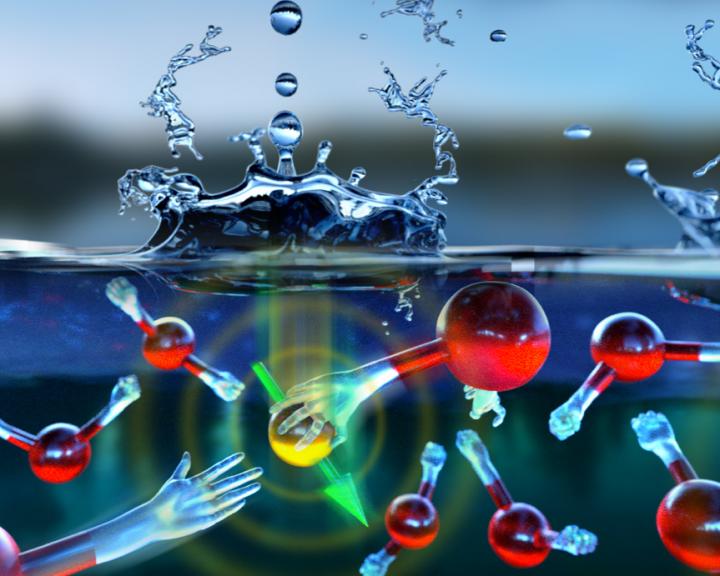Scientists get better numbers on what happens when electrons get wet

A new study paints a more accurate picture of how electrons behave after striking water, and how quickly they're snatched up in chemical reactions. Credit: Peter Allen/Institute for Molecular Engineering
An article published in Nature Communications on Jan. 16 offers a new and better set of numbers from researchers at the University of Chicago, Argonne and Lawrence Livermore National Laboratories, and the University of California-San Diego. By improving computer models, these numbers may eventually help scientists and engineers create better ways to split water for hydrogen fuel and other chemical processes.
When an electron is injected into water, the liquid captures it. The energy gain due to this process is called the electron affinity of water, and it's key to understanding and modeling processes such as those occurring in photoelectrochemical cells to split water to generate oxygen and hydrogen, according to Alex Gaiduk, a postdoctoral fellow at UChicago and the lead author of the study.
Until now, scientists faced technical challenges while experimentally measuring the electron affinity of water, said coauthor Giulia Galli, the Liew Family Professor at the Institute for Molecular Engineering at the University of Chicago and senior scientist at Argonne.
“Most of the results quoted in the literature as experimental numbers are actually values obtained by combining some measured quantities with crude theoretical estimates,” Galli said.
Accurate theoretical measurements have been out of reach for some time due to the difficulty and high computational cost of simulating the interactions of electrons with water, said University of California-San Diego Professor Francesco Paesani, a co-author of the study who has spent years developing an accurate potential for the modeling of liquid water. But through a combination of Paesani's models, Galli's group's theoretical methods and software and Argonne's supercomputer, they arrived at a new and surprising conclusion.
Fundamentally, the researchers sought to understand whether the liquid binds the electron right away. This determines whether the electron can eventually participate in chemical reactions as it hangs out in the liquid.
According to the results, the electron is bound, but its binding energy is much smaller than previously believed. This prompted the researchers to revisit a number of well-accepted data and models for the electron affinity of water.
“We found large differences between the affinity at the surface and in the bulk liquid. We also found values rather different from those accepted in the literature, which prompted us to revisit the full energy diagram of an electron in water,” said Lawrence Livermore National Laboratory scientist and coauthor T.A. Pham.
This finding has important consequences both for the fundamental understanding of the properties of water, as well as for understanding a type of reaction called reduction/oxidation reactions in aqueous solutions. These reactions are widespread in chemistry and biology, including how cells break down food for energy and how objects corrode in water.
Particularly, the information about the energy levels of water is often used during the computational screening of materials for photoelectrochemical cells to break apart water to produce hydrogen as fuel. Having a reliable estimate of the water electron affinity will lead to more robust and reliable computational protocols and better computational screening, the researchers said.
The methods for excited states used in this study were developed over the years by Galli and her co-workers, within collaborations involving Pham and Marco Govoni from Argonne. The study also used supercomputing resources at Argonne.
Media Contact
All latest news from the category: Physics and Astronomy
This area deals with the fundamental laws and building blocks of nature and how they interact, the properties and the behavior of matter, and research into space and time and their structures.
innovations-report provides in-depth reports and articles on subjects such as astrophysics, laser technologies, nuclear, quantum, particle and solid-state physics, nanotechnologies, planetary research and findings (Mars, Venus) and developments related to the Hubble Telescope.
Newest articles

NASA: Mystery of life’s handedness deepens
The mystery of why life uses molecules with specific orientations has deepened with a NASA-funded discovery that RNA — a key molecule thought to have potentially held the instructions for…

What are the effects of historic lithium mining on water quality?
Study reveals low levels of common contaminants but high levels of other elements in waters associated with an abandoned lithium mine. Lithium ore and mining waste from a historic lithium…

Quantum-inspired design boosts efficiency of heat-to-electricity conversion
Rice engineers take unconventional route to improving thermophotovoltaic systems. Researchers at Rice University have found a new way to improve a key element of thermophotovoltaic (TPV) systems, which convert heat…



